In this era of evolving tech gadgets, listening to music has become more accessible. One can easily listen to music with their smartphones, earbuds, headphones, speakers, amplifiers, etc.., While hundreds of digital media players arrive on the market every year, many of us are missing the actual essence of the traditional analog music record players. Turntable is one such music player that is being in use by humankind for several decades.
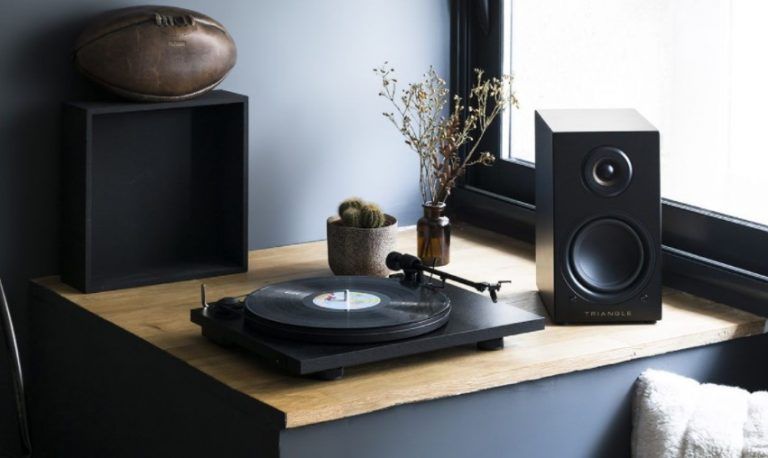
In this guide, we will discuss in detail each and every aspect of the turntable. Right from Turntable types, glossary of terms to buyer’s guide and setup tutorials, we got you covered everything. We will make sure you get a clear picture of what is in turntable by the end of this article. Let’s get started!
WHAT IS A TURNTABLE?
A vinyl turntable is an electronic device that allows you to play LP (Long Play) records. The turntable, therefore, allows the playback of the music embedded on vinyl records in 33 rpm, 45 rpm, and sometimes even 78 rpm format. The components of turntable include a tonearm, a diamond, a cartridge, a drive belt, and much more. These components can be repaired or replaced over time. A maintained turntable can thus be kept for many years.
TYPES OF TURNTABLES
Based on the position of the motor placed, there are two primary types of turntables. They are,
- Direct Driven Turntable
- Belt Driven Turntable
DIRECT DRIVEN TURNTABLE
This type of turntable is the most famous of all. Unlike the belt-driven turntable, the motor and the drive are in the same housing. Thus, the user will only have to place the disc on it and put the metal end in order to make it resonate.
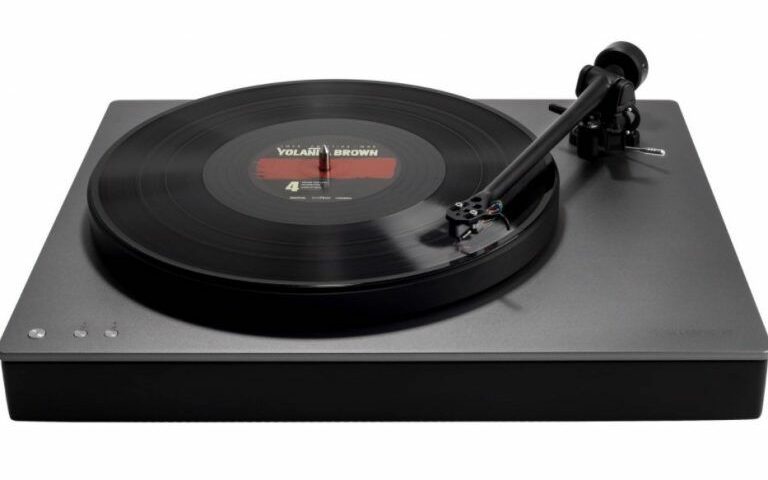
The motor is placed directly under the platter linked to the axis. As a result, direct-driven turntables allow instant start and stop of the turntable, Therefore, it will be suitable for radio use or for mixing techniques used by DJs, such as scratching. This arrangement makes it easy to handle. Indeed, DJs tend to slide their hands over black discs to make effects during the party.
However, the influence of the wind and other noises impact the quality of the sound obtained. Moreover, with such an assembly, it’s possible to get an extremely stable reading speed which is an important factor in analog music.
Pros:
- The higher torque offers the platter less sensitivity, making it suitable for DJs’ to create special sound effects.
- The higher torque helps to accelerate the platter to achieve its constant speed in no time.
Cons:
- The motor is directly connected to the platter, and it generates unwanted vibrations that can affect the quality of sound. This can be resolved using some shock absorbers between the motor and the platter.
BELT DRIVEN TURNTABLE
This is the inexpensive type of turntable that you find on the market. This type of engine operation is very economical since it requires few parts. The turntable has a motor fixed next to the platter with a single belt located around the motor axis, and it drives the platter according to the selected rotation speed.
The turntable belt drive generates little vibration, almost non-existent noise in operation, and its initial start-up time is slower when compared to the direct-drive turntable.
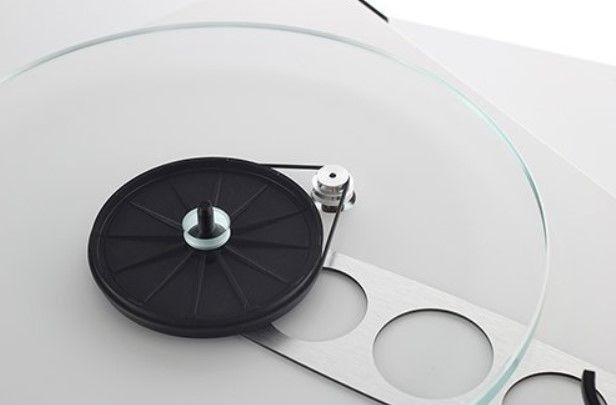
These easy-to-use automatic vinyl turntables allow you to read, digitize and listen to your favorite vinyl records anywhere at a lower cost. On the other hand, on belt-driven vinyl turntables, the motor is off-center with respect to the platter and is connected to it by a rubber belt.
Therefore, belt drive bridges have lower torque, and their speed fluctuations are larger. In addition, on this type of turntable, the rubber belt wears and slackens over time, requiring regular maintenance.
Pros:
- The elastic belt can absorb shocks, thereby preventing the platter from experiencing any vibrations created by the motor.
- Less noise transmission since the motor is isolated from the platter.
- Produce better sound.
Cons:
- The elastic belt might lose it’s tension after sometime and needs to be replaced.
Note:
There is yet another type of turntable known as Idler Wheel Turntable which is quite less popular comparatively.
IDLER WHEEL TURNTABLE
This is a less common turntable, yet worth mentioning which is used rarely by people. It works similar to direct drive but has a small rubber wheel of about 1.5” in diameter inside the rim connected to the motor shaft under the platter. It requires higher torque to rotate the platter at a constant speed. It can provide the result as much as a Direct drive turntable but often encounter some issues, requiring intensive care and maintenance.
Idler wheel was a simple, dependable, and gutsy drive system. Some popular models of the Idler wheel turntable are the Miracord 50H Mk II and 40A, the Dual 1009 and 1218, and most of the Garrards RC-88 of 1960.
Pros:
- It works pretty similar to the Direct Drive turntable and is able to produce the same torque as it.
Cons:
- The system has too many parts in it. Even to do a single action, all the parts are needed to be in proper sync.
- It has too many parts, and if it encounters an issue, it’s quite hard to identify the malfunctioning components.
- The wheel gets slippery over time.
TURNTABLE GLOSSARY OF TERMS
ANTI SKATING: This term refers to the centripetal force exerted on the cartridge, which during playback pushes the diamond into the interior of the vinyl record. The force must be applied according to the specifications of the cell manufacturers and the arm.
AZIMUT (OR TILT): The angle between the plane of the vinyl record and the vertical axis of the Hi-Fi cartridge. The angle must be perfectly horizontal to avoid an imbalance between the two channels, additional distortion, and groove wear.
BANDWIDTH: Bandwidth refers to the range of frequencies that the device is capable of processing. It is expressed in Hz. The first digit indicates the minimum response in the bass and the second digit indicates the maximum in the treble.
PHONO CELL CONNECTION TERMINALS: For mounting a Hi-Fi cartridge, it is necessary to connect four wires from the turntable arm to the corresponding terminals on the read head.
These are often arranged as follows:
- “+” – left channel: WHITE
- “-” – left ground: BLUE
- “+” – right channel: RED
- “-” – right ground: GREEN
ARM: Element of the vinyl turntable, which supports the turntable’s cartridge.
CANTILEVER: It is noted that the crew of a cell consists of three elements: the stylus (stylus), the cantilever, and the suspension. The cantilever is a small arm protruding from the phono cartridge and supporting the stylus. Its role is to faithfully transmit the diamond’s vibrations in the groove of the vinyl to the mobile part of the cell.
CAPACITY: Accumulation of electrostatic charges between two conductors insulated from each other. It is measured in microfarad.
CELL/CARTRIDGE: This is one of the main components of a turntable that is used for playing a vinyl record. Its role is to convert the mechanical oscillations undergone by the stylus into an electrical signal of low voltage.
CHARGE: This technical term designates the characteristics of the phono cartridge from an electrical point of view. These parameters will determine the choice of the pre-amplification stage for the most faithful reproduction possible.
COUNTER-PLATE: The counter-plate is the part where the shaft of the drive shaft rests.
COUNTERWEIGHT: Found at the end of Tonearm. It is used to adjust the support force undergone by the diamond of a cell, to attain a very precise reading mechanism.
DAMPER: A damper is used to reduce the vibrations induced by the motor and other vibratory elements.
CROSS- TALK: When the signal of the right channel overlaps with the left channel’s signal and vice versa on the cell, it is referred to as cross-talk.
DISTORTION: Distortion of the signal occurs due to poor quality or defective elements, and it results in creating imprecise, distorted, or even unpleasant sound signals.
DYNAMIC: Difference (in decibels) between the maximum level and its minimum level of a signal.
CHANNEL BALANCE: The capacity of a cell to identically reproduce a signal on its two channels (output sound signal).
TRACKING FORCE: This is the vertical force experienced by the phono cartridge in a vertical plane perpendicular to the vinyl record. This can be neutralized by using record weights and stabilizers.
GAIN: In musical terms, the gain is also known as amplification. It is used to determine the ability of your turntable to increase the amplitude of the signal. The gain is generally calculated by the ratio of the input signal to the output signal. It is expressed in decibels.
IMPEDANCE: Any electronic circuit can slow down the electric current, which is specific to it. This measurement is called the impedance of the circuit. We can distinguish it into input and output impedance.
LP: This term refers to Long Playing or long duration. It refers to33 rpm vinyl records.
MC (MOVING COIL): This cartridge has a very efficient technology but is much more complicated to assemble and therefore much more expensive. This technology is reserved for high-end cartridges. Their output level is low, generally less than 0.8 mV, so they require a suitable phono preamplifier or a transformer. However, they allow a high output level (usually greater than 2mV) and, therefore, adapt to all standard phono preamplifiers. Note that the diamond is not interchangeable!
MM (MOVING MAGNET): These are the most common and the simplest cartridge mechanism to manufacture and, therefore, the least expensive. Their diamond is interchangeable; their output level is generally greater than 2mV, allowing it to adapt to all phono preamplifiers on the market.
MONO OR MONAURAL: It means only one audio signal transmission channel is required to reproduce monaural recording. It should be noted that most of the LP records with a release date prior to 1960 are almost entirely recorded in mono. Likewise, all 78 rpm records are mono recordings.
CLAMP: Its function is to keep the disc perfectly level on the platter.
PLATTER: Part of your turntable where you place the vinyl records. It can be made in different materials.
PLATTER MAT: It is a disc-shaped object placed on top of your turntable platter. The purpose of a turntable slipmat is to keep your record in place. It also reduces the rumble and dampens any mechanical noise from the turntable motor. It is made up of many materials like rubber, cork, acrylic, leather, silicon, and much more.
CRYING: Sound distortion caused by a speed difference between recording and playback on your turntable.
PIVOT: Mechanism allowing the Tonearm to pivot horizontally and vertically while minimizing stress and friction.
PHONO PREAMP: The role of a phono preamplifier is to magnify the very low amplitude sound signals to a standard level signal. It carries out the amplification of a signal coming from a phono cell and produces a signal with the minimum possible distortions at the final sound reproduction.
RAY: The radius of a diamond for cell phono measures about one micrometer (a thousand times smaller than a millimeter!).
RCA: Modulation or phono cable used to connect a variety of video and audio devices.
FREQUENCY RESPONSE: This is a measurement used to judge the quality of reproduction of a HI-FI cell reading a particular sound signal. The frequency response is nothing more than the result of this experiment, and it is often presented in the form of a graph representing the amplitude in volts as a function of the frequency in hertz.
RESISTANCE: This can be a physical principle allowing to reduce the conduction of the electric current. Resistance can also be a component that dissipates heat.
RIAA: This acronym reads Recording Industry Association of America. It refers to an inter-professional organization whose objective is to defend the interests of the vinyl record industry in the United States. This organization was formed in 1952 and, after the commercial beginnings of vinyl records. It defined a unique curve of pre-emphasis on engraving and de-emphasis on records. This organization also represented the format of the groove of a stereophonic disc and the dimensions of the discs themselves.
RUMBLE: Very low-frequency vibration causing a humming effect
STYLUS: Or diamond, this is the stylus of your moving magnet hi-fi cell.
POWER SOCKET: This connection is used to supply the turntable from the mains and to operate it.
DRIVE BELT: It comes in the form of an elastic and allows you to turn the turntable. The drive belt absorbs the vibrations of the engine and thus prevents parasitic noises. Depending on your turntable model, the drive belt may vary, which is why we offer a wide selection of vinyl turntable belts.
TONEARM: It is a key part of the turntable because it supports the phono cartridge. There are different models of Tonearm: the size, the material used, technology, etc.
TURNTABLE STAND: The record player stands are also an essential part of a turntable setup. It isolates the record player from unwanted vibrations from the surrounding environment. The stand/storage might be a dedicated turntable stand, the top shelf with an equipment rack, a wall-mounted stand, or simply a strong shelf or even a table. Regardless of the modules, the primary goal of the turntable stand is to maximize the turntable’s isolation.
FEET: The base of the turntable rests on several feet. Depending on your turntable model, they may be adjustable, of different sizes, different compositions, etc.
HOW TO CHOOSE THE RIGHT TURNTABLE?
There are various turntables available on the market. Whether you are looking for a HiFi turntable or a simple record player with built-in speakers, there are some important criteria one should consider while purchasing a turntable.
BUDGET
We can segregate the budget turntables section into three options: Entry-level, mid-range, high-end. Every turntable might seem like it includes everything, and sometimes it is difficult to see big differences between a simple vinyl player and one that will cost 5 to 10 times more.
They might have their differences, but basically, a turntable is a turntable, and it will allow you at least to play a vinyl record. So why spend several hundred dollars on a record player?
Well, the more precise answer is, some manufacturers are trying to get the perfect sound, and hence they will dive into multiple innovations to achieve the purest sound, anti-vibration systems, and extremely precise mechanisms. Such complex systems are more expensive for a rather marginal benefit on the sound rendering.
Good Entry level Turntable (Considerably less than $400) :
- Entry-level cartridge
- Built-in preamp
- Aluminum platter and tonearm
- Some plastic body parts
- Automatic operation
Mid-range Turntable (between $400-$800):
- Manual operation
- Medium-quality cartridge
- Heavy plinth (base)
- Carbon fiber tonearm
- Steel or acrylic platter
Best High-end Turntable ($800 and above):
- No built-in preamp
- High-end cartridge
- Exotic, sometimes trademarked materials in the platter, bearings, and other parts
- Advanced engineering of tonearm assembly, plinth, wiring, etc.
For better and decent sound quality, it is recommended to get a mid-range turntable. You can find many good quality turntables under 1000. If you can spend a little more, consider getting a high-end, wireless Bluetooth turntable or USB turntable to digitize your vinyl records.
Note:
There are also USB turntables that offer a USB port to record your vinyl records in .mp3 format. In some models, the turntable can even be powered directly via USB.
AESTHETICS
The aesthetic feature of turntables is also important to consider; After all, they are a real decorative object these days. They come in different styles for all tastes and all interiors. Starting from a simple design like the RP110 to the more rustic RP155, and even more portable suitcase-style like RP140, they got it covered.
The design will generally have no impact on the intrinsic performance of the turntable but having a beautiful turntable is, of course, very positive on the aesthetic side. A good-looking turntable is not necessarily a good turntable. Besides, you can choose the style yourself!
BELT DRIVE OR DIRECT DRIVE
This is probably one of the most important distinctions in choosing a turntable.
A belt-driven turntable has a motor that is not linked to the platter axis, but it is suspended or attached to the platen via a belt. This avoids problems of vibration and transmission of external sounds. For HIFI use and home use, this is undoubtedly the best solution. These belt plates are lighter, but one day it will be necessary to replace the belt, which will eventually relax.
Conversely, a direct drive vinyl player offers a motor directly linked to the platter on which the record will rest. This system will allow the net stop of the plate as well as instant starts. They are generally much heavier because they are equipped with quality construction to avoid pollution linked to engine vibrations. They will therefore also generally be more expensive.
DJs usually choose the direct-drive turntable because the playback speed is particularly stable and the wow rate extremely low. They also allow a faster stop and start and backtracking for scratches, which is necessarily a plus for professional use.
MANUAL OR AUTOMATIC STAGE
The automatic vinyl turntable itself operates the arm with its cartridge to play the record. It is convenient. It not only raises the arm when reading but also as soon as your record ends to come back to its support automatically.
As its name strongly suggests, it will need the user’s intervention to manually actuate the arm regarding the manual stage. Therefore, you will have to position the cartridge yourself on the record, and in the same way, once the record is finished, place the arm back on the support. In fact, you will find a large majority of manual turntables, which many prefer for their more authentic feel. Its mechanism is also simpler, which will last longer.
The automatic turntable offers the advantage of limiting the risk of the cartridge and the diamond slipping on the disc. This reading mode will also prevent cell wear by systematically stopping reading at the end of listening. The manual turntable, on the other hand, continues to turn infinitely at the end of the disc.
PREAMPLIFIERS AND AMPLIFIERS
Turntable naturally produces a very low-intensity electrical signal, That cannot be processed as it is. The strength of the signal has to enhance so it can be sent and then processed by the amplifiers and speakers. This is where the phono pre-amplifier comes in, and it helps to amplify the low-intensity signals.
In general, Some turntables directly integrate such a preamplifier built-in, while others do not. If you are going for a standalone preamp, you have two choices: an integrated amplifier or a stereo receiver. Stereo receivers have pretty much all: phono preamplifier, amplifier, and tuner. Integrated preamps lack with tuner, but you can add a separate tuner to it if you want. Many audiophiles and higher-end listeners specifically prefer the integrated tube amps for their ability to yield warmer musical tone and more musical-sounding distortion.
Standard turntables will sometimes have a preamplifier that allows them to be easily connected to most speakers or home cinema-type systems. With a phono preamp, you will have a more precise signal, and this is an important point for audiophiles.
Conversely, standalone turntables without a preamp offer you the freedom to upgrade your turntable with a high-quality phono preamplifier to enhance the turntable signals.
CARTRIDGE QUALITY
The cartridge is represented by the small case and the diamond located on the front of the arm. The cell containing the magnetic coils collects the signal, and then sends it to the amplifier. It plays a key role in acoustic rendering. Turntable cartridges include two main types of cell :
1. MM cartridge or moving magnet cartridge is by far the most used cartridge to date. They mostly work with all phono pre-amplifier models and allow the diamond tip to be changed very easily. They are present on most consumer models, entry, middle, and top of the range.
2. MC cartridge or moving coil cartridge, is intended for high-end products. The sound reproduction is excellent and the most appreciated by sound enthusiasts. However, they require suitable equipment such as a preamp. Also, unlike the MM cell, you will need to change the entire cell most of the time.
PLAYBACK SPEED
The playback speed depends on the Vinyl disc size you want to listen to. The most common are 33 rpm (or more precisely 33 and 1/3), also known as LPs, and 45 rpm. These two formats are generally supported by the vast majority of decks, even the cheapest. Rarer are the models which also offer the possibility of reproducing 78 rpm records or EP.
So it is generally necessary to have a special cartridge that can correctly read the tracks of this format. It is therefore important to check your vinyl collection before choosing a particular product.
SIGNAL TO NOISE RATIO
The signal-to-noise ratio indicates the proportion that links the audio signal level to that of the noise, which is the fundamental data for understanding the quality of musical reproduction.
The higher the signal-to-noise ratio, the better the turntable quality, as the music will outweigh the buzz and interference of the signal. For a high-quality result, we recommend models with a signal-to-noise ratio above 65 dB.
WOW AND FLUTTER
Wow and Flutter indicates how precise the rotation of the disc is. Considering that minimal speed variations are enough to decrease the quality of the audio reproduction, it is essential that the turntable can guarantee the highest possible precision.
The lower the Wow and Flutter data, the better the product will be: we generally recommend choosing devices with a value below 0.25%.
HOW DOES A TURNTABLE PLAY RECORDS?
The working principle behind the turntable is pretty simple. Let me explain how it works and plays records.
- A groove on a vinyl record is the engraving of the vibration of sounds recorded in the studio.
- When the record is placed on the vinyl turntable, it will cause the rotation of the record. The regularity of the rotation is ensured by a sensor in the plate, which measures the time for a revolution, to guarantee the constant speed of rotation, between 33 or 45 rpm.
- A vinyl turntable has a motor. For a direct drive turntable, this motor is fixed directly on the axis of rotation. For a belt-driven turntable, the motor is installed sideways, and the axis of rotation is driven by a belt that links.
- The main difference between the two is that the direct drive is suitable for the activity of a DJ since it controls directly from the source and acts on the speed of rotation which reacts instantly. However, the vibrations are felt directly, and the listening quality is affected. In belt-driven turntables, the belt absorbs these vibrations. But, the belt does wear out, and it will need to be replaced at some point.
- The diamond, which in reality a sharp point on the stylus, travels through the groove and reads this engraving to transcribe the sound into the amplifier, which will transmit it to the loudspeaker.
- The performance of the motor and/or the belt is, therefore, ensures the quality of music that you are listening on a turntable.
This is how a vinyl turntable works. So, for those who just want to listen or want to become a DJ, it’s important to know how it works and how to use it properly. And more importantly, it will require necessary precautions, record cleaning tools, and maintenance measures to ensure its longevity and listening quality.
WHAT IS A PHONO PREAMP IN TURNTABLE
The sound from the turntable is obtained by the displacement of the stylus in the grooves of the vinyl record. These undulations create sound with very low intensity at the output of the cartridge. But these sound signals are too low to be processed directly by an amplifier, and hence they must be pre-amplified.
Thus, in 1954, the Recording Industry Association of America (RIAA) proposed a standard based on the curves of the RCA and Victor companies. Very quickly, all the companies adopted this pre-emphasis which we now call “RIAA.”
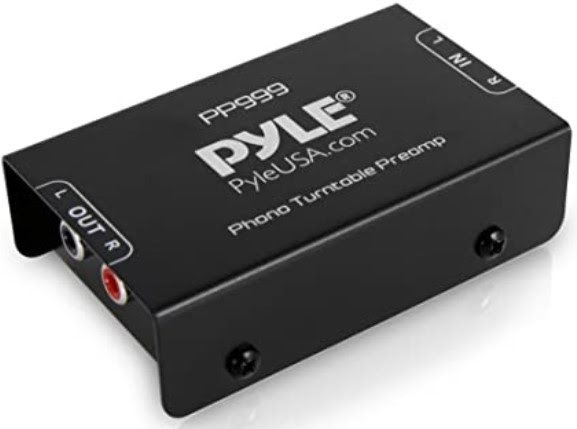
Most vinyl records pressed after 1955 were therefore recorded with RIAA filters. For this reason, it is necessary to use a phono preamplifier when playing a vinyl record.
Yes, I hear you saying that Amplifiers are made for this purpose only. But, if you want to connect your amplifier to a turntable, then they must have a phono input, and most of the amplifiers today don’t come with a phono input port (97% of amplifiers do not have one. ). To do this, you will have to take an extra step in your installation. You need to get an amplifier with phono input so that the sound from your turntable reaches your speakers!
But its role does not stop there !! Indeed, the phono preamplifier also corrects the engraving curves. Thus it uses an inverse curve: schematically, the vinyl is engraved following a bell curve, and an anti-bell curve is applied to reading. This allows the bandwidth of vinyl to go down to 20 Hz (bass). I hope now you understand better why the phono preamplifier is so essential.
COMMON TURNTABLE SETUPS PROCEDURES
1. How To Set Up Turntable And Powered Speakers
This is one of the most common and easiest methods to connect your turntable and powered speakers. Note that not all turntables have inbuilt preamps, so make sure your turntable has one.
- Powered speakers are integrated with amplifiers, and hence you won’t require any additional components.
- Connect your Turntable and speakers with an RCA cable.
- Plug the turntable and speakers into power outlets.
- Place the record on the turntable and press the playback button to enjoy!
2. How To Set Up Turntable + Preamp + Powered Speakers
There are two main reasons why you need a preamp between your turntable and your amplifier,
- To improve quality and better process the signal.
- When your turntable doesn’t have one.
The setup process is quite simple. It is similar to the previous one, except for the fact that you need to connect a preamp between the turntable and the powered speakers.
- Connect your Turntable and the phono preamp with an RCA cable.
- Then connect the phono preamp out to the powered speaker’s input with another set of RCA cables.
- Plug the turntable and speakers into power outlets.
- Place the record on the turntable and press the playback button to enjoy!
Handling the connection of multiple components can be confusing. If you mess with the connection it might result in adding extra noise and vibrations to the system. If you want to avoid such risk you can opt for an all-in-one record player which comes with all this equipment inside it.
3. How to set up Turntable + A/V Receiver + Passive Speakers
Let‘s say you have a home theater for multipurpose activities like playing music or watching movies or events for playing games. It is possible to connect your turntable to your AV receiver and listen to the record playback with the home theater effect.
- Connect your Turntable and your AV receiver with an RCA cable.
- The receiver can then be plugged with 2 or more speakers.
Using this setup, you can connect your turntable to an existing speaker system.
Note:
To make this setup you will need a turntable or AV receiver with an inbuilt preamp.
4. How to connect Turntable + Preamp + A/V Receiver + Passive Speakers
When Neither the turntable nor the receiver has a built-in phono preamp, you need to get a separate one for configuring the setup. You need to Connect the phono preamp between the turntable and the receiver.
- Plug the turntable’s output audio cable into the input of the phono preamp’s input. Make sure to connect the turntables ground wire to the ground port present on the phono preamp.
- Then connect the phono preamp’s audio output into one of your receiver’s analog audio inputs, connect the preamp to its power supply, and you’re all set.
5. How to connect Turntable + Standalone Speaker (wired RCA to aux connection)
This setup is similar to the Turntable And Powered Speakers setup mentioned above. The only difference, this device is used, and the setup is even more compact. Likewise, it requires a turntable with an inbuilt preamp; else, you will probably need a separate phono preamp.
- Standalone Powered speakers are integrated with amplifiers.
- Plug your Turntable and speakers with a 3.5 mm RCA adapter(RCA to AUX cable).
- Plug the turntable and speakers into power outlets.
- Place the record on the turntable and press the playback button to enjoy!
The major drawback of this setup, it didn’t achieve the expected stereo separation properly in your soundstage. Despite such things, many people use this connection for its simplicity and compactness.
6. How to connect Turntable + Bluetooth Speaker
It might sound absurd to talk about using cables with Bluetooth speakers, but the fact is you are going to need some RCA cable if you want to connect to a turntable with a Bluetooth speaker.
If you use a Bluetooth turntable, then follow the below steps.
- Turn on the Bluetooth pairing mode on both the turntable and speaker.
- Once the device gets paired, you can place the record on the turntable and start playing it.
If you don’t have a Bluetooth turntable but still want to connect your turntable with a Bluetooth speaker, then follow the below steps.
- Turntables typically have two RCA ports (a red one and a white one)
- Most Bluetooth speakers have RCA ports. This makes it possible to connect it with your turntable.
However, most Bluetooth speakers don’t have RCA inputs, and they have a single 3.5mm AUX input. So you’ll likely need to invest in an inexpensive RCA to 3.5mm cable. It has two large red and white RCA connectors on the end that connect to the turntable (or pre-amp) and a single 3.5mm connector (that looks like the one on your headphones) on the other.
DIFFERENT TURNTABLE DESIGNS & FUNCTIONALITIES
Vinyl is now back into the picture with a whole upgraded level of advanced features. Premium turntable brands around the world have stepped into the turntable market, offering turntables with audiophile-grade sound on every budget. So, Whether you are getting your first turntable are planning to replace an old deck, here are some turntable modules and functionalities you need to look into.
Bluetooth Turntable

Bluetooth Turntable are usually equipped with an integrated preamplifier and amplifier, and they are a modern way of listening to vinyl. They allow you to connect your turntable to Bluetooth speakers or headphones. Be careful, though!
This may seem like a good idea, but you should know that the theoretical Bluetooth speed varies according to the versions of the interface. You will therefore have to check the Bluetooth version of your turntable and also of your speakers!
However, be aware that the signal must be digitized and will therefore suffer a loss of quality.
Automatic Turntable
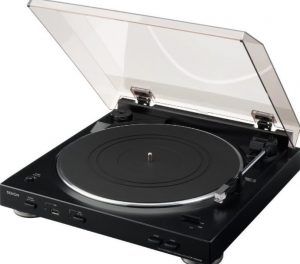
This is the most sought-after type of turntable and is much appreciated for its ease of use. Indeed, it is equipped with a high-performance motor, automatically operates the actions of the tonearm, and even brings it back to its support once the end of the disc side is finished.
All you need to do is connect the turntable to the speakers and simply turn on/ off the button to start playback
Vertical Turntable
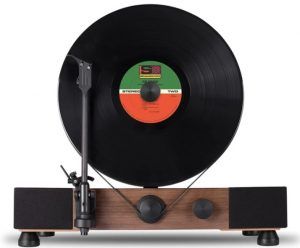
This innovation in the turntable is pretty cool. Have you ever seen a modern vertical record player? This Vertical turntable is also known as Floating Record has a unique artistic audiovisual design and offers excellent acoustic performance.
The device integrates an amplifier and speakers to limit the addition of additional equipment. The Output sound quality is not up to the benchmark.
However, it is still possible to connect the device to an amplifier and external speakers with an RCA output and a 3.5 mm mini-jack. In order to allow vertical reading, the arm applies constant pressure.
Portable Turntable
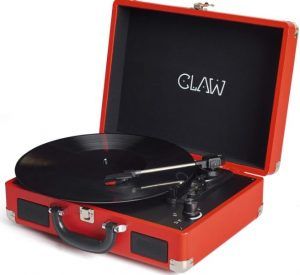
These are distinguished by their small size, which greatly facilitates their transportability. Portable turntables are equipped with speakers that allow the user to listen to their vinyl at any time and anywhere they are. Finally, to function, they come with a rechargeable battery.
Vintage Turntable
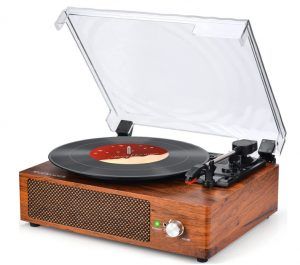
If you are looking for record players with a classic touch, getting a vintage turntable will be ideal. A new turntable with high core performance can cost you more. On the other hand, old, used record players (vintage record players) can produce the same routine for a much lower price.
They are tried and authentic players, made with better quality elements and materials. Because of its superior products, they are capable of delivering better record sound.
Also, remember, the turntable is vintage, which means they have old gears and might also break down. In that case, you might have to replace them.
TOP TURNTABLE BRANDS
AUDIO TECHNICA TURNTABLE
The brand was created in Japan in 1962 by Hideo Matsushita. The manufacturer specializes in mid-range and high-end products. The turntables are robust and have become benchmark products in the HiFi world, particularly in terms of technological innovation. It is to this day the most famous brand of turntables.
CROSLEY TURNTABLE
The Crosley company has made a lot of talk in recent years, especially thanks to its colorful line, Crosley Cruiser. The Crosley brand specializes in sound equipment and also manufactures many versions of recording players. They have a large selection and tend to adhere to the cheapest range on the market.
Some of their products are completely inexpensive and have never been made with the best parts, but a few of their turntables are cheap gemstones which is why they were included on our list. Trendy and modern, these turntables have captivated thousands of consumers. If you don’t want to spend too much and place great importance on design, these models are for you.
PROJECT TURNTABLE
Pro-Ject was launched with the hope of creating a line of quality yet affordable turntables. It could thus revive a vinyl industry than on the verge of extinction completely. Over 25 years later, the Project turntable has risen to the forefront of a booming vinyl renaissance. The project has revolutionized the turntable market by offering high-performance devices at affordable prices.
Heinz Lichtenegger, one of Austria’s leading premium audio distributors, founded Pro-Ject Audio Systems in 1991. Heinz used Pro-Ject audio systems as a powerhouse to bring premium equipment to the masses. Since then, Pro-Ject has continued to grow. It has established itself today as one of the most respected names in terms of analog equipment.
They redefined the possibilities in premium audio by proving that big things come in small sizes. The Project turntable exists a priori for all budgets while providing excellent performance for their price range.
FLUANCE TURNTABLE
Fluance, the company which addresses itself more particularly to the world of speakers. After the late 90s, they eventually expanded their product range and have made a name for themselves and a growing reputation with customers. They are known for their economy. turntable models, perfect for small budgets and moderate requirements. Their aesthetics have a traditional/vintage look that is very appealing, and functionally they do what is expected of them.
SONY TURNTABLE
Sony is a priori one of the most recognized brands around the world, regardless of the industry. This company is a great leader in consumer electronics in many countries. It is also present in the film production and music recording sector. His career shows great financial successes, multiple innovations, and daring leadership.
Founded in 1945, Sony has forged its reputation for creativity in leadership with its current name. Sony produces both commonly used turntables and specific deejaying models. Some turntables of its manufacture compete with major competing brands such as Audio Technica or Pioneer. Sony turntables also have the advantage of being more affordable.
ION TURNTABLE
Ion Audio is one of the manufacturers of electronic devices. It is a private company located in Cumberland, England. It was created in 2002 and generally supplies audio devices and accessories intended for the general public.
This brand has set itself the goal of manufacturing audio and video products capable of converting all kinds of analog files into digital files, and this is especially what sets it apart from other brands in this field. Ion Audio turntables stand out from other models usually found on the market. Ion For fans of vintage cars, this brand has opened a special collection for them.
For example, you can find Mustang-style turntables. Ion Audio’s turntables are also known to be multifunctional as some cover several options like FM radio, conversion, wireless connection, CD player, and cassette player at the same time. As a result, several of the models of this brand meet with success with users. The most requested model is the Mustang LP turntable.
DENON TURNTABLE
Denon is a Japanese company that has been manufacturing HI-FI devices, vinyl turntables, CD players, phono cartridges for turntables, and more since 1910. Denon’s history begins with the manufacture of vinyl records. The company will subsequently become a prestigious multinational in the audio field.
We are talking about a company that has a good command of its subject in everything it develops, creates, and markets, so it is in peace that we tested Denon turntables without losing our critical sense. It is recommended to vintage lovers, especially for its design strongly resembling the turntables of the 70s. The brand offers entry and mid-range models.
REGA TURNTABLE
Created in 1973 by Relph and Gandy in England. It manufactures mid-range and above all high-end products. The brand is renowned for the purity and robustness of the sound of its turntables. Rega exclusively produces very high-quality professional turntables with exceptional performance and is aimed at a niche market. Ideal for those who demand the best and can invest a larger budget in purchasing a vinyl player.
THORENS TURNTABLE
Very few brands of turntables can boast of having such rich equipment as that of Thorens. The history of this company can, in fact, be traced back to the 1800s. Since then, the Thorens turntable has been established among the legendary products in the hi-fi equipment world. The quality of Thorens products has greatly improved since the inception of this brand.
The Thorens brand began in 1883 by manufacturing clock movements. In 1957, Thorens became a legend by producing the TD124 turntable. At present Thorens is one of the best references for record players and other analog devices.
PIONEER TURNTABLE
Pioneer is one of the oldest brands in the field of audio equipment manufacturing. The brand was created in 1938 in Japan by designer Nozomu Matsumoto. It very often presents the best turntables for comparison. The brand receives positive votes from customers, and its products are often displayed as the winners of the 2019 hi-fi systems.
Today, Pioneer offers a wide range of items and is constantly evolving to ensure that its products always meet the technological demands of consumers.
U-TURN TURNTABLE
U-turn Audio, is a US-based turntable brand founded by three real vinyl enthusiasts in 2012. Since then, they started making benchmark models in the vinyl player sector and have entered the Hi-Fi market with stylish turntables. This brand has been people’s first choice because of its quality and reasonable price.
They are well known for their manual and belt-drive turntables that offer both simplicity and great sound quality. Their Orbit turntables are featured with a timeless vintage design which includes a solid wood plinth and stunning build quality. The fit and finish of their turntable are simply unbelievable with the price range they offer.
DUAL TURNTABLE
The Dual turntable brand was established in 1927. The name ‘Dual’ itself is said to be derived from their concept of dual power supplies for electricity and wind-up energy. The turntable company Dual, however, has survived far beyond that original technology that inspired their name.
Dual produced its first turntable in the late 1930s, following the development of its phono cartridge. In the 1970s, the brand produced direct-drive and belt-driven turntables to compete with its competitors, such as the Audio Technica turntable brand. Most models of Dual vinyl turntables are primarily designed for playing vinyl music.
This is especially true for the older models of this brand of hi-fi equipment. However, there are also models of Dual vinyl turntables suitable for Deejaying activities.
VICTROLA TURNTABLE
Victrola corporate branding was founded in 1906 in Camden, New Jersey, by the Victor Talking Machine Company (“Gis Master Voice”), which had its heyday by placing the phonograph in a wooden cabinet. The American manufacturer Innovative Technology has imposed itself in 2017 and created turntables with combined entry-level electronic components with contemporary features, such as Bluetooth, digitization, all in a generally decidedly vintage design.
FAQ
1. How Do I Choose The Right Cartridge?
The cell/cartridge is the part that comes into contact with the front of the arm and the disc. It is located on the front of the tonearm, represented by a very small case and with a diamond at the needle. Its role is to retrieve the signal to send it to the amplifier. This is one of the key criteria for the acoustic rendering of the turntable. There are types of cells,
- The MM cartridge is a moving magnet cartridge that works with all models of phono preamplifiers. It is the one that is present on the majority of devices.
- The MC cartridge is a moving coil cartridge suitable for high-end models with excellent sound reproduction.
2. Are Turntable Cartridges Interchangeable?
Yes. Turntable cartridges are interchangeable. When your diamond is worn, it is necessary to replace only the stylus, not the entire cartridge. Of course, many people replace the original cartridge with a better one to improve the sound quality, which is optional.
Each turntable is unique, so it is better to refer to the product’s manual to know more about the cartridge. Turntables with MC cartridges typically don’t have a replaceable stylus; you have to replace the entire cartridge in such a case.
3. How To Align Cartridge Turntable?
Turntables that come with a pre-assembled cartridge are usually also pre-adjusted at the factory. Hence you need to calibrate or balance and make basic adjustments to the tonearm. But if you are going to install a new cartridge, you must make the necessary adjustments for the proper functioning of the turntable.
There are various factors to consider like Tonearm swing, Anti-slip, Vertical Tracking Force, Azimuth, and a few more. The simplest way to align the cartridge is to use a Cartridge Alignment Protractor and follow its instruction manual.
4. How To Replace Turntable Needle?
Locate the stylus and check whether it is interchangeable or not. If it is removable, the task will be much easier. If not, you have to get a new cartridge. The below steps are applicable only if the stylus is interchangeable.
- Remove the cartridge shell and gently unscrew it from its position.
- Now pull the needle from the cartridge.
- Insert the new needle in that position. Now gently place the screws and tighten them up (screw supplied with the needle).
Note: Make sure you have a screwdriver, a stylus dynamometer, tweezers, and needlepoint pliers.
5. Is It Bad To Leave A Record On The Turntable?
Actually, leaving a stylus on a record is perfectly fine, and it won’t cause any damage to the record. Leaving a Record on the Turntable for a long time can cause damage. It might expose the disc/records to more dirt and dust accumulation. If you leave your turntable to run overnight, then it might cost you to decrease the lifespan.
6. Can You Connect A Turntable Directly To Speakers?
Yes, it is possible to connect a turntable directly to the speakers, but only with the provided requirements. Either your turntable or speaker should have an inbuilt preamp in them. Else you have to get a separate phono preamp for your turntable.
7. How To Replace The Turntable Belt?
First, you need to know about your turntable’s old belt. Diagnose whether their problem is with your belt. If it is necessary to change the belt, then note the brand, material, and dimensions of your belt and purchase the same belt as the old one. Now follow the below steps.
- Turn off the power supply.
- Remove the turntable mat and the platter.
- Now turn the removed platter upside down and place it on a flat surface.
- Replace the old belt with the new one around the platter.
- Place the Platter back on the Spindle.
- Rotate the platter so that the square opening of the platter comes directly over the motor pulley.
- Now stretch the belt over the motor pulley.
- Place the turntable mat on the platter.
It is advised to use the ribbon given with the belt for the stretching process to avoid any kind of damage.
8. Do I Need A Preamp For My Turntable?
Of course, you will need a preamp for your turntable. The sound of a turntable usually produces low-level signals that must necessarily be pre-amplified.
9. How Do I Hook Up A Phono Preamp For Turntable?
Most of the turntables include inbuilt phono preamps, as it is a mandatory part for amplifying the low-level turntable signals to a standard level signal. However, some high-end turntables don’t include a preamp; you have to get a separate phono preamp in such a case.
10. How To Clean Turntable Needles?
There are various tools and processes to clean turntable needles. Here is the list of possible ways to clean turntable needles.
- Using needle brush
- Zero Dust
- Using Liquid Stylus cleaner
11. Does My Turntable Need An Amplifier?
A turntable needs a preamp and amplifier to play vinyl records. The output signal of the turntable is not strong enough to drive speakers unless the turntables come with a built-in preamp. You can also use powered speakers, as they have inbuilt amplifiers.
12. Do All Turntables Have RCA Outputs?
Most of the features of the turntable with RCA output and RCA cables are used to carry the left and right channel signals.
13. How Do I Play My Turntable Through Wireless Speakers?
There are two possibilities by which you can connect your turntable to wireless speakers.
- Using Bluetooth adapters – You can connect the Bluetooth adapter in TX mode to your turntable and then pair it with your Bluetooth speaker.
- Getting a Bluetooth turntable – These turntables will have an inbuilt Bluetooth feature. All you need to is pair it with your speakers and play the music.
14. Do I Need To Put A Mat On Top Of My Turntable’s Platter?
Technically, a platter mat is used to reduce the resonances and other vibrations caused by the platter, surface, motor, and other components of the turntable. It acts as a shock-absorbing layer, and damage thereby protects the record for distortion. It also provides a HiFi listening experience
CONCLUSION
We have gone through all the most important aspects of the turntable. We have also explained the different options available to you before buying a turntable online. We hope by now, you have clarity on the turntable. Do not hesitate to tell us in the comments if you have any questions or suggestions. Meanwhile, take a look at the commonly asked questions related to Turntable.
